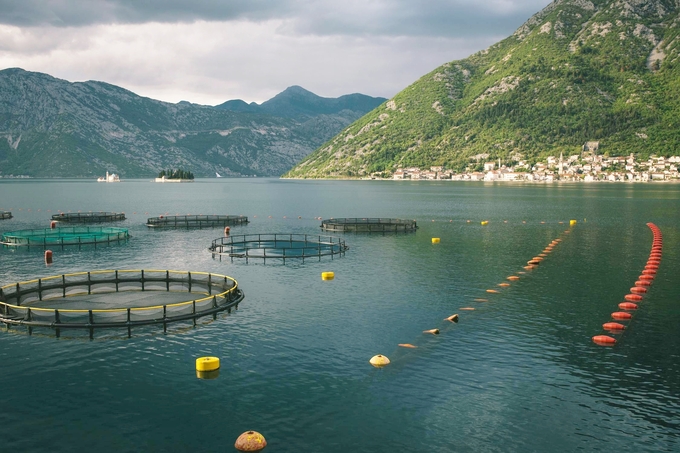December 30, 2025 | 15:37 GMT +7
December 30, 2025 | 15:37 GMT +7
Hotline: 0913.378.918
December 30, 2025 | 15:37 GMT +7
Hotline: 0913.378.918
According to new research from the University of Michigan (U-M), humanity can exploit more food sources from the ocean to meet global demand while reducing the negative impact of the marine farming on biodiversity, but this can only be achieved if this industry is carefully managed.
Deqiang Ma, the main author of the study and a doctorate researcher in the environment and sustainable U-M, said, “We can develop sustainable mariculture. With a reasonable planning strategy, we can both preserve marine species and meet the needs of expanding marine farming globally”.

It is crucial to make full use of the increasingly deep understanding from a wide variety of fields, from climate change science, and economy to marine farming. Photo: Vadim Braydov.
Mariculture accounted for approximately one fifth of the total aquaculture production in 2020 and is now an important source of protein for billions of people. As the demand for aquatic products increases, production is promoted to strengthen output as a response. To predict the impact of this boom, Ma and the international research team have built a model to assess the effects of marine farming on more than 20,000 marine species.
The team has used this model to measure the current impact of the industry and forecast changes to 2050, depending on the type of aquatic products raised and the farming location. The model also considers two different climate scenarios, called RCP 4.5 and RCP 8.5, assuming the different levels of heating and emissions of greenhouse gases. In the best scenario, the construction of farms in the most environmentally friendly areas brings promising results for both farmed mollusks and fish.
On the contrary, the worst scenario shows alarming results. If new farms are built in areas with the biggest negative impact on the biodiversity, the consequences may be four times higher than choosing a random farming location.
“This emphasizes the importance of strategic planning and the need to cooperate with experts from many fields to come to a comprehensive view. Taking advantage of the increasingly deep understanding from many different fields, from climate change science, and economy to marine farming is extremely important. All of these factors need to be synthesized so that we can make accurate forecasts,” said Neil Carter, senior author of the research.
The research team emphasizes that this study is only the first step towards a more sustainable future for marine farming. They also note that the model can continue to be improved by adding new data. One thing to add is that there is no common plan for all situations, for instance, farm development strategy in the South Pacific may not be suitable for the French coast.
Even in the most optimal scenario, there are still trade-offs. To give an example, the development of marine farming negatively affects sea mammals such as whales, seals and sea lions in all cases. By understanding these limitations and trade-offs, researchers and policymakers will be able to make better plans and wiser decisions.
“With specific knowledge, we can see that the expansion of an industry does not necessarily lead to negative impacts on the environment. Therefore, policy and community makers need to cooperate to find a way to develop sustainable mariculture, minimize negative impacts and prioritize conservation of marine biodiversity,” Carter said.
The consolidation of the Ministry of Agriculture and Rural Development and the Ministry of Natural Resources and Environment into the Ministry of Agriculture and Environment can bring many advantages to the field of marine farming.
This field was previously under the overlapping management between the two ministries. The Ministry of Agriculture and Rural Development was responsible for the development of the fisheries sector, while the Ministry of Natural Resources and Environment managed marine resources, licensing water use and environmental protection. This separation sometimes makes it difficult for businesses, cooperatives and farmers when they need to solve problems related to the farming waters.
Vietnam has a great advantage in developing "green" and sustainable mariculture thanks to having a long coastline, favorable natural conditions and abundant aquatic resources. In the context of the government’s strengthening of marine economic strategies, the mariculture industry has great opportunities to develop in the direction of modernity with environment-friendly approaches that increase economic value.
Translated by Samuel Pham

(VAN) From extensive shrimp ponds, baskets of don gathered on the mudflats, to boats carrying visitors to watch birds, all livelihoods here depend on clean water, green forests, and the calls of migratory birds.
/2025/12/26/0703-3-204813_117.jpg)
(VAN) Transparency in information and listening to local people have helped address ground clearance bottlenecks and build social consensus, thereby accelerating the progress of the JICA3 irrigation project.
/2025/12/27/0609-3-233846_327.jpg)
(VAN) The JICA3 project is expected to become a 'water shield,' helping control saltwater intrusion, proactively secure water resources, protect livelihoods, and promote sustainable development in coastal areas.
/2025/12/26/5654-3-164509_655.jpg)
(VAN) As Viet Nam makes strong commitments toward achieving net-zero emissions, controlling and reducing methane emissions in livestock production is increasingly becoming a mandatory requirement.

(VAN) 'People, Primates, Plants: Co-managing Biodiversity and Improving Livelihoods in Vietnam' (the PPP Project) is an international initiative implemented in Vietnam by BGCI, CEGORN, and ICRAF/World Agroforestry.

(VAN) Dak Nong established a risk-level zoning map for coffee, built a digital data platform for the sector, and promoted certified production in line with EUDR.
/2025/12/25/2709-1-211551_295.jpg)
(VAN) In response to the U.S. Marine Mammal Protection Act (MMPA), Gia Lai province is implementing many solutions to protect marine mammals and develop sustainable, responsible fisheries.